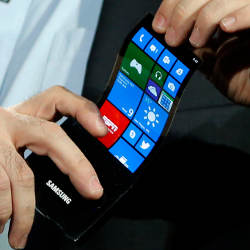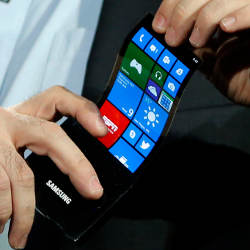
This past January at the Consumer Electronics Show (CES) in Las Vegas, Samsung senior vice president Brian Berkeley offered a look at the future of smartphones and tablets. During a keynote address, Berkeley showed off a prototype smartphone sprouting a thin, bright, and completely flexible display that slid out like a credit card from a wallet. The crowd clapped and cheered while he bent the display as if it were a playing card. A moment later, he reached into his jacket pocket and revealed a device that looked more like a market-ready product than a Star Trek gadget. The prototype resembled a standard smartphone, but the screen wrapped around the sides of the device. This way, Berkeley explained, important messages and updates could be displayed along the edges, like a ticker.
Samsung also offered a video preview of a few even-more-science-fiction-style devices, including a smartphone that opens like a book, transforming into a seamless tablet on the inside, and a cylindrical gadget with a roll-out screen. The presentation was stunning, but also short on details. Berkeley noted that these devices would be enabled by the YOUM brand of flexible organic light-emitting diode (OLED) displays. He speculated that the technology would allow designers to come up with an entirely new ecosystem of devices. However, Samsung did not reveal any potential release dates or many technical specifications.
In fact, the prototypes were not actually functioning phones, and skeptics were quick to note that this was hardly the first time a company had heralded the imminent arrival of bendable displays. Philips revealed a rollable prototype screen in 2005. Nokia introduced its own innovative variation in January 2011. LG, Sharp and other manufacturers have shown off bendable screen technology themselves. Still, there is a growing sense that the latest prototypes are not mere trade show smoke and mirrors, and that the futuristic displays will be moving into the marketplace within the next year, and possibly sooner.
Whether these first actual product iterations prove as exciting as the fully bendable, high-resolution prototypes is another question. Academic experts are skeptical, noting that numerous technological and economic hurdles remain. “You can go to a company now and see this stuff and use it and touch it. We are tantalizingly close,” says materials scientist Andrea Ferrari of the University of Cambridge. “But there’s a huge gap between the lab and the devices on the market.”
Engineering Challenges
The basic technology behind the flat displays in today’s phones and tablets is a sandwich of different material layers. An OLED screen, for example, typically starts with a glass substrate, on top of which is a circuit containing thin-film transistors and a capacitor, then the light-emitting OLED layers and, finally, a transparent, protective layer on top. “A flat panel display screen is a very complicated product,” says Nick Colaneri, director of Arizona State University’s Flexible Display Center. Trying to transform these rigid surfaces into bendable devices only deepens the complexity. “The support system in every flat panel display is a piece of glass, and to make a flexible display, the first thing you have to do is get rid of the glass.”
Colaneri says this essentially requires revising the way companies have built these electronics for years. Samsung and others have already begun to tackle the problem. The Samsung prototypes rely on a new kind of OLED technology in which the rigid glass substrates are replaced by flexible plastic. Yet relying on OLEDs also creates additional challenges, Colaneri says. OLEDs are hypersensitive to oxygen and water, which is not an ideal feature for a consumer product. “They need to be hermetically sealed,” he explains, “and figuring out a low-cost hermetic seal is a huge problem.”
Of course, OLED displays are not the only option. The basic electrophoretic technology behind E-Ink-powered devices, for example, has always been flexible. The catch is that this approach will not achieve the speed or color fidelity of an OLED display, and the electrodes that turn each of the millions of microcapsules either black or white have typically been made using a rigid substrate. Now, however, E Ink has developed a plastic-based thin film transistor that can be laminated to its microcapsule display technology. “The display is ready for implementation,” says Jenn Vail, senior marketing manager at E Ink. “We’re now working with partners interested in launching new devices.”
Relying on plastic substrates might require some unfortunate trade-offs. Due to ever-increasing performance needs, display manufacturers may soon be shifting from amorphous silicon, the material of choice for transistors, toward amorphous oxide semiconductors (AOS) or indium gallium zinc oxide (IGZO) semiconductors. At CES in Las Vegas, Sharp Electronics unveiled a line of stunningly clear IGZO-based screens that could also be curved and bent.
The switch is due, in part, to the fact that thin-film transistors that use AOS will be better equipped to meet the performance needs of tomorrow’s devices. The problem, says John Wager, an electrical engineer at Oregon State University, is that much like their predecessors, AOS transistors run best at higher temperatures. To be compatible with a flexible plastic substrate, which is more susceptible to melting than glass, the process temperature needs to drop, and that translates into lesser performance. “You can make transistors, but they’re pretty poor,” he says.
As a result, Wager is holding out hope that companies like Corning will soon develop an affordable flexible glass that might allow for higher temperatures. In 2012, Corning announced its thin, slightly bendable Willow Glass line, but the company recently explained that truly flexible electronics applications are still several years away.
Potential Applications
Due to all the unresolved questions and technological hurdles, Colaneri expects the first generation of flexible displays to be closer to the immobile wraparound screen Berkeley presented in January than the one he bent like a playing card. In fact, when manufacturers talk about “flexible” screens, they are talking about devices with a range of possible features. At one end of the spectrum lies the version that bends just enough so that it is resistant to shattering, and at the opposite end you have the high-resolution, laptop-sized screen that rolls up tight.
At Arizona State’s Flexible Display Center, for example, Colaneri notes that the goal was never really to push roll-up screens. The mission, he says, was to further the development of light-weight, low-power devices that do not quit functioning when you drop them. Typically, a dropped device does not break because the glass screen cracks; it stops working because of damage to the glass-based transistor layer buried within. Devices with these features are already becoming available. The Wexler Flex ONE, an e-reader based on LG technology, relies on a plastic substrate so it bends just enough to survive being crammed in your pocket, and resists damage from accidental drops.
E Ink is touting its own flexible technology for the same reason. Although the company says it could be used to develop roll-up-style e-newspapers, the real breakthrough may be in creating accident-proof gadgets. This could prove critical for several of the applications E Ink has in its sights, including electronic textbooks for students, a more drop-prone group than adults. “We were also able to make material improvements to increase the ruggedness of the display connectors,” Vail adds.
Flexible screens might also assume forms engineers and designers have not yet envisioned. For example, a pair of ex-IDEO designers recently raised money through a Kickstarter campaign for an E-Ink-based flexible-screen watch called the CST-01.
Colaneri hints that it could take a few years before flexible displays truly find their appropriate niche. “The black-and-white screens that became e-readers started out in lots of other applications before people figured out they wanted e-readers,” says Colaneri. “Flexible screens are in that ugly adolescence right now.”
Whether they mature quickly enough to deliver the roll-out of futuristic, highly bendable screens in the next few years is an open question. Colaneri suspects that vision is still several years away. “Getting to a phone that bends as much as a credit card would before I break it? That’s a ways out there yet.”
Further Reading
Park, Jin-Seong, Chae, Heeyeop, Chung, Ho Kyoon, Lee, Sang In.
Thin Film Encapsulation for Flexible AMOLED: A Review. Semiconductor Science and Technology, February 2011.
Kim, Sunkook, et. al.
Flexible Displays: Low Power Organic Light-Emitting Diode Display Device. Advanced Materials, August 2011.
Crawford, Gregory, editor.
Flexible Flat Panel Displays. Wiley 2005.
Sharp Electronics USA.
IGZO: a video intro to indium-gallium zinc oxide. http://youtu.be/SnUUXoFsjoY
Samsung.
Samsung Flexible Display at CES 2013: ‘YOUM.’ http://youtu.be/N3E7fUynrZU






Join the Discussion (0)
Become a Member or Sign In to Post a Comment